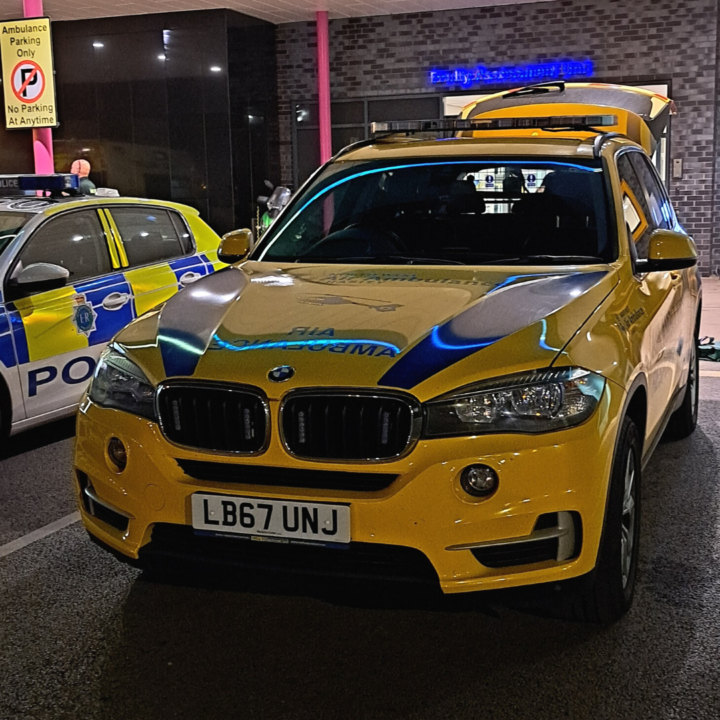Did you know we have a night car service?
Every Friday and Saturday night one of our critical care vehicles is available, onboard is a HEMS Doctor and Critical Care Paramedic who are ready to treat some of the most critically ill and injured patients across the North West. We joined them one evening to see the life-saving work they do.
Our helicopters don’t currently have the capability to fly at night, but it’s something we’re looking into!
Sometimes, it makes more sense to drive a critical care vehicle to a scene as it can save time.

6 pm
Shift starts.
Dr Clint and Critical Care Paramedic Martin begin by prepping the vehicle – making sure they have all they need on board.
Once the kit and car has been checked over the crew are ready to go. The cars have the same equipment that our helicopters carry.
Time for a brew while the crew waits for the call. The crew are sent jobs via call handlers based in NWAS (North West Ambulance Service) call centres, who look for jobs they feel the crew will be needed for.
8 pm
We receive our first call of the night. The crew have been sent to an incident in St Helens.
8.10 pm
On our way to the incident and the crew are stood down as their expertise aren’t needed at the scene.
As the crew are stood down, another job comes in, this time in Bolton. Critical Care Paramedic Martin skilfully drives us through the evening traffic.
The best thing you can do when you spot a response vehicle on the road with blue lights on, keep calm and move out of the way safely if you are able to do so.
8.30 pm
As we approach the scene, the crew are stood down again. Another job comes in immediately over in Stretford.
But this is very quickly stood down as more information on the incident comes through.
It may seem like our crew are stood down a lot, but we would rather be on our way to an incident quickly, than wait.
9 pm
As we turn approach base, the crew are called to an RTC in Rochdale. We make a swift turn around and head across to the scene.
9.25 pm
We arrive at the scene and it is clear that there has been a collision involving two cars. The crew take in a lot of information when they arrive at a scene, they will also inspect the cars to see the damage done to a car.
This can give them a better idea of how a patient was injured.
9.30 pm
At the scene, the patient is awake and in the back of an ambulance being cared for by our brilliant colleagues at NWAS.
The crew have a quick look at the patient to make sure they aren’t needed, before making themselves available again for another job.
9.45 pm
Almost back at base and the crew are called out.
This time we are off to an RTC in St Helens.
10 pm
As we drive along, colleagues monitoring the call give additional information about the incident. This one seems to be that car has hit a pedestrian.
10.10 pm
We arrive at a scene and the patient is with NWAS staff. Police are also on the scene to manage the public, as this has happened on a busy street with lots of bars and takeaways.
Dr Clint and CCP Martin speak to NWAS staff to get a better idea of the situation. Martin then assesses the damage to the vehicle to see if there are any clues as to what happened.
10.20 pm
As the crew prepare to move the patient into the ambulance, their condition changes and the decision is made by Dr Clint to perform a Rapid Sequence Induction (RSI).
Dr Clint manages the scene and with the help of NWAS staff and our critical care paramedic Martin, ensures the procedure is done safely.
An RSI essentially puts a patient to sleep so the crew can control their breathing. It gives the brain a rest, and protects it from further damage. This is something that would normally have to wait until a patient arrives at the hospital.
10.40 pm
The crew accompany the patient from the scene to Aintree Hospital – a Major Trauma Centre that is well-prepared to receive our patient.
From there the patient is handed over to the hospital’s skilled consultants.
11 pm
After completing the paperwork to hand over, the crew have some time to grab a coffee and take a stock check of what was used at the previous incident.
11.30 pm
Martin radios through to call handlers to let them know they are available again. He packs the car up and we make our way back to base once again.
12.20 am
When we arrive back at base, Clint and Martin are straight into stores to replenish their kit. Any controlled drugs that have been used need to be recorded, and then signed out of the safes they are kept in. They’ll also replace other items that were used so the bags are ready to go for the next job.
1 am
Back in the crew’s break room, Clint and Martin have an opportunity to relax. Their shift finishes at 2 am, but after 1.30 am the crew won’t be sent out to a job, except in rare circumstances .
1.30 am
Nothing else comes in and that’s the end of the crew’s shift!
The shift involves a lot of moving around the North West, but the service is providing a great impact on the region. We do everything based on evidence, and we hope that the night car can be rolled out for more hours and with more cars in the future.